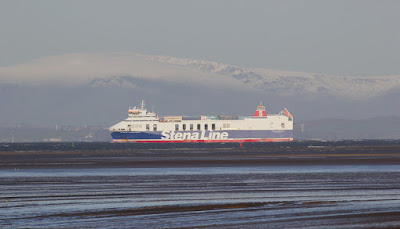After arriving back from holiday late on Sunday it’s been hard to find the time or even the motivation to go birding. But om Wednesday morning I dug my hat, gloves and birding jacket out of the car boot in the sure knowledge that the feel of a Lancashire winter at 5⁰ is in stark contrast to two weeks of Lanzarote’s wall-to-wall sunshine and 23⁰.
Wednesday was my turn on the Oakenclough rota. It was time to top the feeders and check the numbers of birds feeding there in case the weather should relent and allow a ringing session - a week from now looks a possibility after yet another stormy weekend ahead!
Andy topped up last Saturday and reported decent numbers of Chaffinches, Goldfinches and Coal Tits, concentrated as usual in the least windy spots. Three feeders were barely touched, another three close to empty. So it was a minimal top-up in the more exposed feeders and a heftier dollop of nyger in the others. There was nothing in the way of extra species apart from at least two Mistle Thrushes in full voice.
Goldfinch
Mistle Thrush
That was the extent of my birding, so for this post I’m including a few pictures from the Lanzarote of late January.
Lanzarote had enjoyed the driest, warmest November, December and January on record with virtually nil rainfall and endless sunny days. This historic and glorious weather continued during our two week stay with barely a cloud to be seen. We took many coastal walks in the immediate area venturing out in the hire car on just three or four days.
Puerto Calero, Lanzarote
Puerto Calero, Lanzarote
The dryness of the landscape can be seen in the picture above but few walkers ventured from obvious paths to look for birds like Berthelot’s Pipit, Lesser Short-toed Lark, Trumpeter Finch, Desert Grey Shrike or Linnet. A number of Berthelot’s were feeding young but judging by the large numbers of larks around in groups and even small flocks, their breeding season was more advanced. The larks hugged the ground so much in their cryptic brown plumage that it was almost impossible to get close before one exploded into the sky and took many more along. On one walk 40 or more Lesser Short- toed Larks took to the air upon spotting my approach.
From the coastal paths could be seen Sandwich Tern, Kestrel, Yellow-legged Gull, Whimbrel and Common Sandpiper.
On a couple of days and very close to the hotel we found a party of three Hoopoes. In parts of the Mediterranean I’m used to Hoopoes being very approachable but this trio proved hard to close.
Common Sandpiper
On a couple of days and very close to the hotel we found a party of three Hoopoes. In parts of the Mediterranean I’m used to Hoopoes being very approachable but this trio proved hard to close.
Fortunately the dry and dust of the coastal paths would often lead to a watering hole or two for thirsty travellers like ourselves.
There’s more home or away birding soon on Another Bird Blog. Don’t miss it.
Linking today with Anni's Blog and Eileen's Saturday.
Linking today with Anni's Blog and Eileen's Saturday.




































































.jpg)












